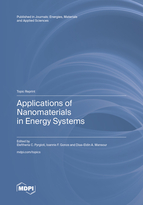Topic Menu
► Topic MenuTopic Editors



Applications of Nanomaterials in Energy Systems

A printed edition is available here.
Topic Information
Dear Colleagues,
Greetings from the Topic Editors.
We are inviting submissions to a Topic on the subject area of “Applications of Nanomaterials in Energy Systems”. This Topic is a multidisciplinary peer reviewed editorial with respect to the state of the art topics on nanomaterials while addressing cutting edge research results on exponential nanotechnology.
Publications related with original experimental work, theoretical research studies, analytical or empirical models that investigate the nanomaterials performance in energy systems, review articles updating the nanomaterials scientific community with state of the art and advances are within the scope of this Topic.
Topics of interest for publication include, but are not limited to:
- Nanocomposite dielectric materials
- Nanotechnology applications in electric components
- Nanomaterials for electrical energy storage devices
- Nanotechnology on energy transmission
- Nanotechnology applications for electrical transformers
- Nanomaterials for energy conversion
- Nanotechnology in electronics
- Super capacitors based on nanomaterials
- Photovoltaics with nanomaterials aspects
- Nanomaterials based batteries
- Nanomaterials for energy storage
- Nanomaterials for heat transfer
- Synthesis and characterization of novel nanomaterials with respect to power/energy systems
- Nanomaterials for optoelectronic/photochemical devices.
Prof. Dr. Eleftheria C. Pyrgioti
Dr. Ioannis F. Gonos
Prof. Dr. Diaa-Eldin A. Mansour
Topic Editors
Keywords
- nanofluids
- nano-insulation
- nanostructured insulators
- dielectric properties, dielectric strength, dissipation factor, breakdown voltage, lightning impulse withstand
- heat transfer, thermal conductivity, heat exchange
- nanomaterials physics
- nano-supercapacitors
Participating Journals
| Journal Name | Impact Factor | CiteScore | Launched Year | First Decision (median) | APC |
|---|---|---|---|---|---|

Energies
|
3.2 | 5.5 | 2008 | 16.1 Days | CHF 2600 |

Materials
|
3.4 | 5.2 | 2008 | 13.9 Days | CHF 2600 |

Applied Sciences
|
2.7 | 4.5 | 2011 | 16.9 Days | CHF 2400 |

Batteries
|
4.0 | 5.4 | 2015 | 17.7 Days | CHF 2700 |

Nanoenergy Advances
|
- | - | 2021 | 31 Days | CHF 1000 |

MDPI Topics is cooperating with Preprints.org and has built a direct connection between MDPI journals and Preprints.org. Authors are encouraged to enjoy the benefits by posting a preprint at Preprints.org prior to publication:
- Immediately share your ideas ahead of publication and establish your research priority;
- Protect your idea from being stolen with this time-stamped preprint article;
- Enhance the exposure and impact of your research;
- Receive feedback from your peers in advance;
- Have it indexed in Web of Science (Preprint Citation Index), Google Scholar, Crossref, SHARE, PrePubMed, Scilit and Europe PMC.

